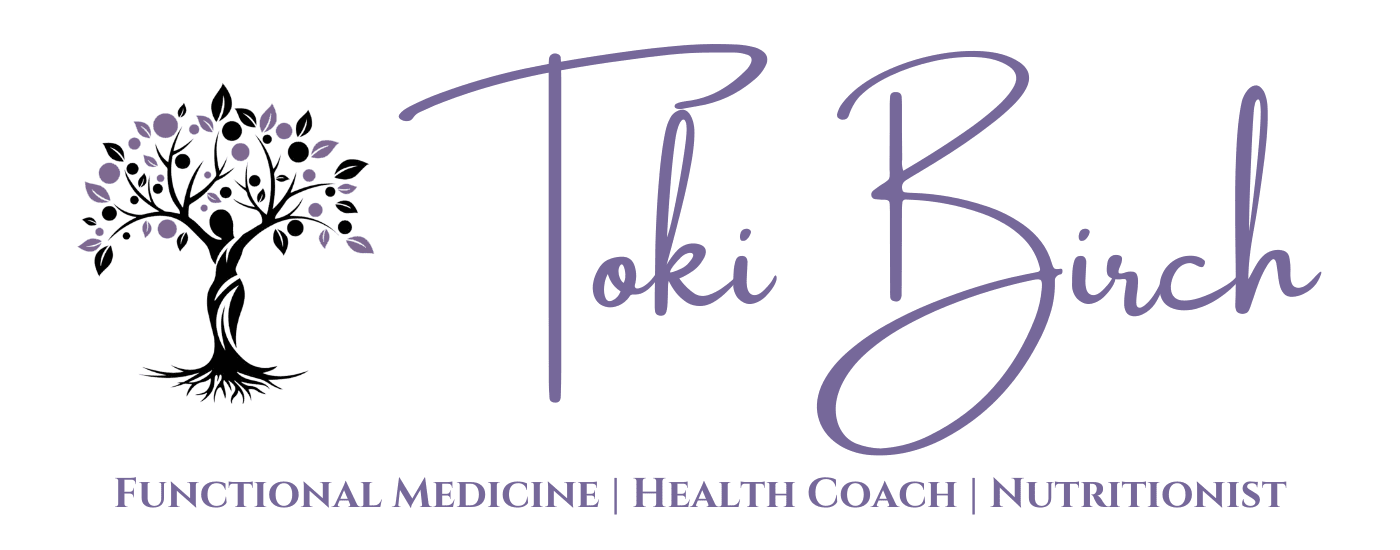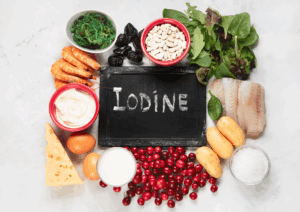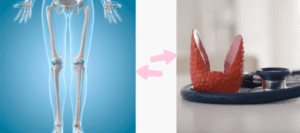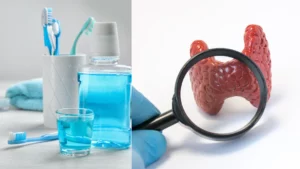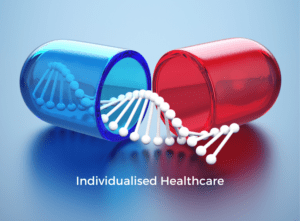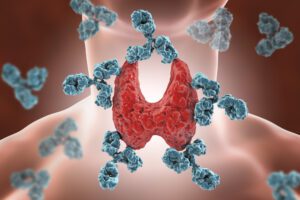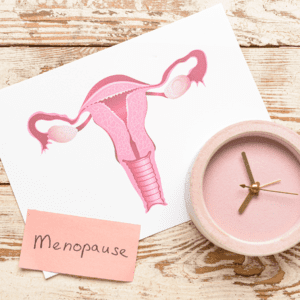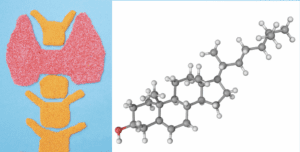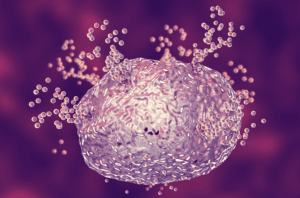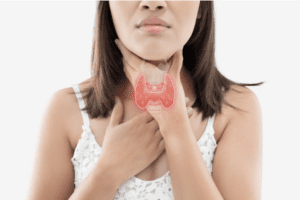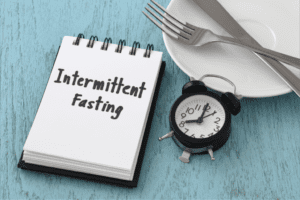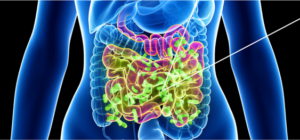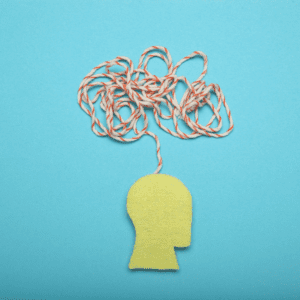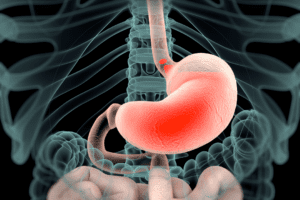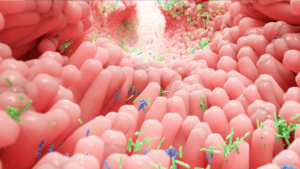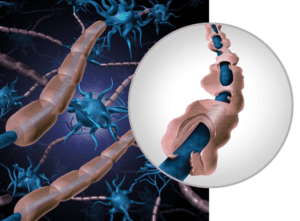THYROID HEALTH ARTICLES
Explore Thyroid-Friendly Tips, Tools, Recipes, and Real Talk for Fatigue, Brain Fog, & Hormone Balance.
From food and supplements, to testing and mindset - these articles are written to help women with underactive thyroid of Hashimoto's finally get the help they need to feel like themselves again.

This article has been medically reviewed by Dr. Charles Penick, MD![]()
Top 10 Thyroid Symptoms: Thyroid disease affects about 1 in 20 people in the U.K. and up to 20 million people in America, the majority being women. And those are only the ones who have been diagnosed. In reality, many people have symptoms of thyroid conditions for years before receiving an actual diagnosis.
Because women tend to be affected more than men (up to eight times more), diagnosis can be difficult. Many initial symptoms can be subtle or brushed off related to a “normal” part of aging, being a mother, or stress.
Understanding your thyroid and the symptoms associated with hypothyroid can help you get the right diagnosis so you can feel better quickly.
Top 10 Thyroid Symptoms: What is hypothyroidism?
Hypothyroidism, the most common of all thyroid disease, occurs when the thyroid gland is either not making enough thyroid hormone, or there is an issue converting thyroid hormone to active forms. There can also be situations similar to insulin resistance where your cells cannot use the hormone even if your thyroid is producing it.
Your thyroid, a butterfly-shaped gland found at the base of your neck, is the metabolic manager for your body. Your thyroid plays a role in many processes:
- Growth and brain development in utero and through childhood
- Hormone synthesis
- Bone health
- Central nervous system function, including temperature control and heart rate
- Mood and cognitive function
- Reproductive health
- Weight management
- Cardiovascular health (including cholesterol levels)
Yet, many people walk around without the proper diagnosis. In fact, the standard labs drawn by most primary care physicians to check for a sluggish thyroid can miss early signs that do show up in other labs but aren’t always drawn. This is the case for Hashimoto’s thyroiditis, an autoimmune version of hypothyroid where the body mistakenly attacks the thyroid gland. Without proper treatment, the thyroid is destroyed by the improper activation of the immune system. Thyroid antibodies can be elevated for years before diagnosis by the standard labs. During this period, you can still experience symptoms even if the values are “within normal limits,” making it essential for you to know what to look for.
What are the top ten thyroid symptoms?
- Constipation. An underactive thyroid slows everything down, including your GI tract. Peristalsis, the automatic wave-like movement by the GI tract muscles, is reduced in hypothyroid, which can cause constipation.
- Dry skin. Your skin cells are continually turning over. When the thyroid isn’t working optimally, this process slows down. As a result, older skin remains on the body longer, which can cause dry, itchy skin.
- Weight gain. Weight gain is the most common symptom associated with hypothyroid. Since the thyroid regulates metabolic function in your body, your ability to burn calories also slows. You can suddenly start gaining weight even without changing any eating habits.
- Fatigue. Since the thyroid controls metabolism and energy levels, feeling extra run down and exhausted is a sure sign that something is off. This is the type of fatigue that persists day in and day out, interrupting your everyday quality of life. It also makes it extra difficult for weight management as you may feel less like working out and instead want to lie down on the couch.
- Feeling cold all the time. Again, your thyroid is a regulator of your metabolism and how efficient you are at burning calories. As that shuts down, your core body temp also cools down. People with hypothyroid may feel especially cold in their feet and hands or have difficulty adjusting to temperature changes.
- Mood changes. Research has connected hypothyroid and depression. The symptoms of both are very similar – weight gain, fatigue, brain fog – making it difficult for researchers to understand the root cause, but evidence points towards a significant relationship.
- Brain fog. Your thyroid has a significant impact on your cognitive function, with a low functioning thyroid impacting concentration and memory. Several studies have shown people with hypothyroid have a difficult time with verbal memory that improves with treatment.
- Hair loss. Thinning hair, including eyebrow hair, are a sign of hypothyroid. Since your thyroid regulates hair follicles, a low thyroid hormone level affects hair growth. This means that you will continue to lose average amounts of hair but won’t regrow the same amount to replace it. The good news is with treatment, hair will usually grow back.
- Weak, achy joints and muscles. A combination of fatigue and muscle breakdown can cause feelings of weakness or achiness for people with hypothyroid. Muscle weakness is a significant issue for thyroid patients, affecting almost 80% of people with hypothyroid. While the reasoning is not well-understood, thyroid hormone deficiency impairs your muscle cells and eventually can lead to muscle atrophy or loss.
- High cholesterol. Does your cardiologist check your thyroid labs? Many are surprised to learn that your thyroid and cholesterol are deeply connected. Low thyroid levels affect the body’s ability to remove LDL cholesterol (the bad cholesterol) and increase the absorption of cholesterol.
You have some of the top 10 thyroid symptoms, now where should you start?
If you found yourself checking the box after each symptom, it’s a good idea to get a workup. As mentioned, the tricky piece of the hypothyroid puzzle is that many of these symptoms are vague – but in combination, they can really add up.
Luckily the combination of appropriate medication with lifestyle changes can make all the difference in how you feel. The first step is getting the appropriate workup, which likely means asking for more than the standard lab order. Make sure you have a conversation with your practitioner or find one who is well versed in thyroid health and start with the following labs:
- TSH: Hypothyroid is characterized by an elevated TSH (thyroid-stimulating hormone), which regulates thyroid production. TSH signals to the thyroid gland to make T4 (thyroxine), which is converted to T3 (triiodothyronine), to be used by the body, but because the thyroid is not responding appropriately, more and more, TSH is pumped out. However, it is possible to have a normal TSH and still have elevated thyroid antibodies.
- Free T4: T4 accounts for most of what is produced by the thyroid (a minimal amount of T3 is produced too). In hypothyroid, T4 is usually low. As mentioned, T4 must be converted to T3, the active thyroid hormone, to be used.
- Free T3: T3 is also low for people with hypothyroid and can even be low with normal TSH if not enough T4 is converted to T3. This poor conversion can still cause symptoms, even if the TSH not abnormal.
- TPO and antithyroglobulin antibodies: These are all measurements of the level of antibodies giving information about autoimmune thyroid conditions. Elevated antibodies mean the body is mounting an immune attack, in this case, on the thyroid.
Top 10 Thyroid Symptoms: Putting it all together
If you are concerned about any of the above symptoms, it’s a good idea to get started with a full workup that includes the above labs. It’s also vital to remember to advocate for yourself – meaning if you have a history of hypothyroid and still don’t feel right, make sure to keep digging. With the right combo of diet, lifestyle, supplements, and in some cases, thyroid medications, you can get your energy and vitality back.
Medical Disclaimer: This article is based upon the opinions of Dr. Daniel Pompa. The information on this website is not intended to replace a one-on-one relationship with a qualified health care professional and is not intended as medical advice. It is intended as a sharing of knowledge and information from the research and experience of Dr. Pompa and his associates. This article has been medically reviewed by Dr. Charles Penick, MD for accuracy of the information provided, but Dr. Pompa encourages you to make your own health care decisions based upon your research and in partnership with a qualified health care professional.
References
- American Thyroid Association. “General Information/Press Room.” Accessed February 8, 2021. https://www.thyroid.org/media-main/press-room/.
- American Thyroid Association. “General Information/Press Room.” Accessed February 8, 2021.
https://www.thyroid.org/media-main/press-room/. - Yen, P. M. “Physio logical and Molecular Basis of Thyroid Hormone Action.” Physiological Reviews 81, no. 3 (July 2001): 1097–1142. https://doi.org/10.1152/physrev.2001.81.3.1097
- Yen, P. M. “Physiological and Molecular Basis of Thyroid Hormone Action.” Physiological Reviews 81, no. 3 (July 2001): 1097–1142. https://doi.org/10.1152/physrev.2001.81.3.1097.
- Smith, Jeremy W., A. Tudor Evans, B. Costall, and James W. Smythe. “Thyroid Hormones, Brain Function and Cognition: A Brief Review.” Neuroscience and Biobehavioral Reviews 26, no. 1 (January 2002): 45–60. https://doi.org/10.1016/s0149-7634(01)00037-9.
- “(PDF) The Hypothalamic‐Pituitary‐Thyroid Axis and the Female Reproductive System.” Accessed February 8, 2021. https://www.researchgate.net/publication/227963560_The_Hypothalamic-Pituitary-Thyroid_Axis_and_the_Female_Reproductive_System.
- National Institute of Diabetes and Digestive and Kidney Diseases. “Hashimoto’s Disease | NIDDK.” Accessed February 8, 2021. https://www.niddk.nih.gov/health-information/endocrine-diseases/hashimotos-disease.
- Daher, Ronald, Thierry Yazbeck, Joe Bou Jaoude, and Bassam Abboud. “Consequences of Dysthyroidism on the Digestive Tract and Viscera.” World Journal of Gastroenterology : WJG 15, no. 23 (June 21, 2009): 2834–38. https://doi.org/10.3748/wjg.15.2834
- Safer, Joshua D. “Thyroid Hormone Action on Skin.” Dermato-Endocrinology 3, no. 3 (2011): 211–15. https://doi.org/10.4161/derm.3.3.17027.
- Chaker, Layal, Antonio C. Bianco, Jacqueline Jonklaas, and Robin P. Peeters. “Hypothyroidism.” Lancet (London, England) 390, no. 10101 (September 23, 2017): 1550–62. https://doi.org/10.1016/S0140-6736(17)30703-1.
- Louwerens, Marloes, Bente C. Appelhof, Herman Verloop, Marco Medici, Robin P. Peeters, Theo J. Visser, Anita Boelen, Eric Fliers, Johannes W. A. Smit, and Olaf M. Dekkers. “Fatigue and Fatigue-Related Symptoms in Patients Treated for Different Causes of Hypothyroidism.” European Journal of Endocrinology 167, no. 6 (December 1, 2012): 809–15. https://doi.org/10.1530/EJE-12-0501.
- Warner, Amy, Awahan Rahman, Peter Solsjö, Kristina Gottschling, Benjamin Davis, Björn Vennström, Anders Arner, and Jens Mittag. “Inappropriate Heat Dissipation Ignites Brown Fat Thermogenesis in Mice with a Mutant Thyroid Hormone Receptor Α1.” Proceedings of the National Academy of Sciences110, no. 40 (October 1, 2013): 16241–46. https://doi.org/10.1073/pnas.1310300110.
- Dayan, Colin M., and Vijay Panicker. “Hypothyroidism and Depression.” European Thyroid Journal 2, no. 3 (September 2013): 168–79. https://doi.org/10.1159/000353777.
- Samuels, Mary H. “Psychiatric and Cognitive Manifestations of Hypothyroidism.” Current Opinion in Endocrinology, Diabetes, and Obesity 21, no. 5 (October 2014): 377–83. https://doi.org/10.1097/MED.0000000000000089.
- “Thyroid Hormones Directly Alter Human Hair Follicle Functions: Anagen Prolongation and Stimulation of Both Hair Matrix Keratinocyte Proliferation and Hair Pigmentation | The Journal of Clinical Endocrinology & Metabolism | Oxford Academic.” Accessed February 8, 2021. https://academic.oup.com/jcem/article/93/11/4381/2627273.
- Fariduddin, Maria M., and Nidhi Bansal. “Hypothyroid Myopathy.” In StatPearls. Treasure Island (FL): StatPearls Publishing, 2020. http://www.ncbi.nlm.nih.gov/books/NBK519513/.
- Bano, Arjola, Layal Chaker, Francesco U. S. Mattace-Raso, Aad van der Lugt, M. Arfan Ikram, Oscar H. Franco, Robin P. Peeters, and Maryam Kavousi. “Thyroid Function and the Risk of Atherosclerotic Cardiovascular Morbidity and Mortality: The Rotterdam Study.” Circulation Research 121, no. 12 (December 8, 2017): 1392–1400. https://doi.org/10.1161/CIRCRESAHA.117.311603.
share this POST
Articles
Is Iodine Safe for Women with Underactive Thyroid or Hashimoto’s?
By Toki Birch | | Autoimmunity, Functional Medicine, Gut Health, Hypothyroid, Inflammation, Thyroid, Thyroid hormones, Thyroid Support
Does Thyroid Medication Cause Bone Loss? What the Research Says
By Toki Birch | | Bone Health & Longevity, Functional Medicine, Hypothyroid, Thyroid, Thyroid hormones, Women's Wellness
Fluoride and Thyroid Health: How It Affects Your Energy & Hormones
By Toki Birch | | Hypothyroid, Natural Remedies, Thyroid, Thyroid hormones
4 Foods to Include in Your Diet If You Have an Underactive Thyroid
By Toki Birch | | Functional Medicine, Hypothyroid, Inflammation, Thyroid, Thyroid hormones, Uncategorized
Autoimmune Diseases in Women: Understanding the Risks and Importance of Lifestyle, Diet, and Gut Health
By Toki Birch | | Autoimmunity, Gut Health, Natural Remedies, Thyroid Support, Women's Wellness
What Is Functional Medicine?
By Toki Birch | | Functional Medicine, General
Learning to Live with Hashimoto’s Thyroiditis
By Toki Birch | | Autoimmunity, Hypothyroid, Inflammation, mold toxins, Mood disorders, mould toxins, Thyroid, Thyroid hormones
Functional Medicine and Menopause
By Toki Birch | | Menopause
Happy YOU Year! Leap into the New Year with real resolutions – and make them stick!
By Toki Birch | | Detox, Detoxify, General
Three Reasons to Go Easy on Gluten
By Toki Birch | | Autoimmunity, Gut Health, Inflammation
Thyroid Stimulating Hormone (TSH) and Cholesterol
By Toki Birch | | Cholesterol, Thyroid, Thyroid hormones
Are You Suffering from Histamine Intolerance?
By Toki Birch | | Gut Health, HIstamine, Histamine Intolerance, Inflammation
Top 10 Thyroid Symptoms That You Shouldn’t Ignore
By Toki Birch | | Hypothyroid, Thyroid, Thyroid hormones
8 Intermittent Fasting Benefits
By Toki Birch | | Autoimmunity, Detox, Inflammation
Periodontal Disease and C-Reactive Protein (CRP)
By Toki Birch | | Heart Disease, Inflammation, Oral health
Restless Leg Syndrome and IBS
By Toki Birch | | Gut Health, Mood disorders, Stress Management
Symptoms of SIBO: You May Be Surprised
By Toki Birch | | Detox, Gut Health, Mood disorders, Stress Management
Probiotics and Gut Health: Is Your Probiotic Harming Your Gut?
By Toki Birch | | Gut Health, Uncategorized
Top Sleep and Anxiety Strategies
By Toki Birch | | General, Mood disorders, Stress Management, Uncategorized
Does the FODMAP Diet Help or Harm?
By Toki Birch | | Gut Health, Inflammation
Understanding SIBO
By Toki Birch | | Gut Health, Inflammation
Mycotoxins (Mold) and Anxiety
By Toki Birch | | Autoimmunity, Detox, Gut Health, mold toxins, Mood disorders, mould toxins, Stress Management, Uncategorized
Anxiety and Depression – Brain On Fire?
By Toki Birch | | Mood disorders, Stress Management
Could Your Thyroid Be Why You Are Not Feeling Well?
By Toki Birch | | Autoimmunity, Detox, mold toxins, mould toxins
The #1 Thing Not to Take For Acid Reflux
By Toki Birch | | Autoimmunity, Gut Health
Emotional Wellness: 6 Techniques to Detox from Emotional Toxicity
By Toki Birch | | Stress Management
Feeling Stressed, Anxious or Fatigued? Maybe It’s Poor Gut Health
By Toki Birch | | Autoimmunity, Gut Health
How To Treat Acid Reflux (GERD)
By Toki Birch | | Autoimmunity, Gut Health
Why Your Probiotic May Be Causing You More Harm Than Good
By Toki Birch | | Autoimmunity, Gut Health, Inflammation
Why Optimal Gut Health Is Key To Losing Weight For Women
By Toki Birch | | Autoimmunity, Gut Health
How to Naturally Remedy Anxiety by Balancing the Gut
By Toki Birch | | Autoimmunity, Gut Health
The Magic of Frequency Specific Microcurrent
By Toki Birch | | Frequency Specific Microcurrent
What Does Gluten Free Really Mean?
By Toki Birch | | Autoimmunity, Gut Health
Multiple Sclerosis in Women.
By Toki Birch | | Autoimmunity
Frequency Specific Microcurrent
By Toki Birch | | Autoimmunity, Frequency Specific Microcurrent, Gut Health, Stress Management
Top 10 Strategies for Restoring Your Gut Health
By Toki Birch | | Gut Health
Discovering Your Self-Worth Despite Challenging Circumstances.
By Toki Birch | | Stress Management
Mental Health, Inflammation and Mood Foods
By Toki Birch | | Stress Management
Can Fermented Foods Make You More Sociable?
By Toki Birch | | Gut Health, Stress Management
EVERYTHING YOU NEED TO KNOW ABOUT IRRITABLE BOWEL SYNDROME
By Toki Birch | | Gut Health, Stress Management
YOUR GUT-BRAIN AXIS: HOW TO DESTRESS NATURALLY
By Toki Birch | | Gut Health, Stress Management
THE ROLE OF LEAKY GUT IN AUTOIMMUNE DISEASE, ALLERGIES, AND STRESS – PART 1
By Toki Birch | | Autoimmunity, Gut Health
The Top Foods You Should Be Eating for Total Body Health
By Toki Birch | | Gut Health, Stress Management
THE ROLE OF LEAKY GUT IN AUTOIMMUNE DISEASE, ALLERGIES AND STRESS – PART 2
By Toki Birch | | Autoimmunity, Gut Health
Take the Free Thyroid Quiz
Still tired all the time? In less than 2 minutes, pinpoint whether your thyroid needs help.
Toki Birch is a certified functional medicine practitioner helping women over 40 reverse underactive thyroid and bring about remission from Hashimoto’s naturally.
FOR SUPPORT ISSUES OR QUESTIONS, PLEASE EMAIL US AT SUPPORT@TOKIBIRCH.COM
